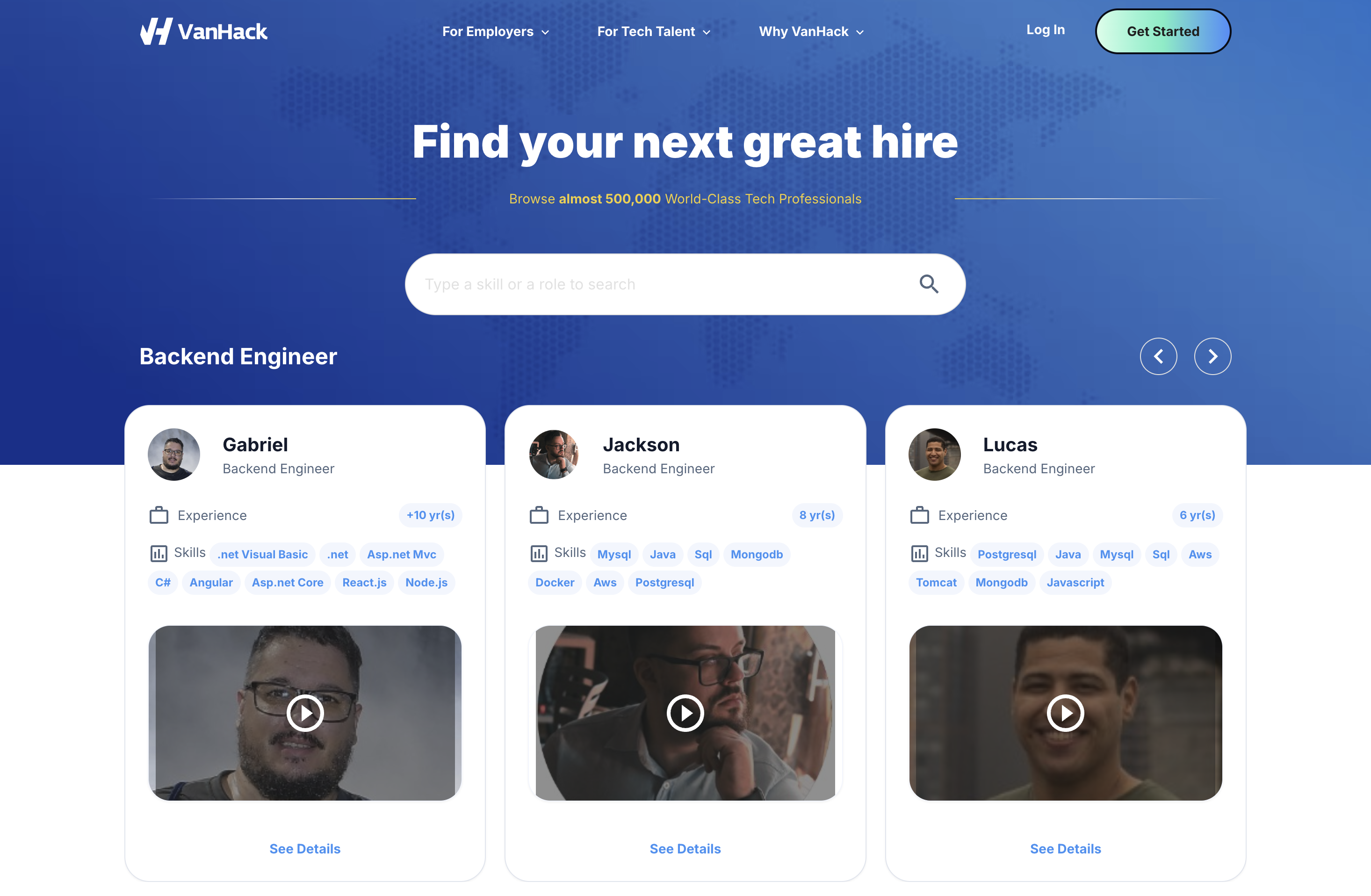US companies are tapping into a valuable opportunity by hiring remote developers from Latin America. This approach provides access to skilled senior talent at lower costs, convenient time zone overlap for real-time teamwork, and a large pool of engineers ready to tackle innovative projects. Still, international hiring comes with hurdles like legal differences and cultural integration.
For startups at Series A to Series C stages aiming to grow their tech teams quickly, getting remote LATAM hiring right is a must for staying competitive. The real task isn’t just finding talent, but identifying, evaluating, and onboarding the best fit while handling compliance, budgets, and team dynamics.
This guide offers seven clear strategies to improve your global hiring process, helping you build strong remote teams that fuel growth. Want to speed up your search? Hire top talent now with VanHack and access a world of skilled developers.
Step 1: Write Job Descriptions That Connect with LATAM Developers
A strong start to hiring remote LATAM developers is creating job descriptions that appeal across borders. International hiring needs a tailored approach that addresses what drives LATAM developers while clearly showing what your company offers.
Focus on growth potential, company values, and your commitment to remote work. LATAM developers often value loyalty and seek companies that support their career development. Highlight paths for advancement and learning opportunities.
Include these key points in your postings:
- Shared values and collaboration focus: Show how your company prioritizes transparency, respect, and inclusion.
- Specific tech skills and projects: Detail the tools and innovative work candidates will handle to boost their skills.
- Career growth options: Mention mentorship, training budgets, or chances to attend industry events.
- Clear pay and benefits: Explain your compensation approach, aligning with local market rates. Hiring in LATAM can cost about 75% less than in the US, while still offering pay well above local averages.
- Remote work support: Highlight flexible hours, digital tools, and virtual team activities.
Keep the tone professional yet approachable, avoiding complex jargon or local slang that might not translate well. Stick to universal ideas like innovation and teamwork to connect with a diverse audience.
Step 2: Use Targeted Platforms to Find Senior LATAM Talent
Standard job boards like LinkedIn often don’t cut it for reaching LATAM developers with the right skills and cultural fit. Specialized platforms with a focus on Latin American tech talent make sourcing easier by offering deep regional insights and connections.
Platforms like CloudDevs, Revelo, LaHire, and Turing stand out for sourcing senior LATAM developers with thorough vetting and focused candidate pools. Each provides specific strengths, from niche expertise to tailored support.
Managing multiple platforms can slow you down with fragmented processes and added coordination. That’s where a single, focused solution like VanHack offers clear benefits.
Here’s what sets VanHack apart:
- Extensive pre-vetted network: Over 500,000 candidates, cutting down on multi-platform sourcing.
- AI matching with “Vanna”: Uses advanced language models to pair job needs with candidate skills for accurate shortlists.
- Unified hiring dashboard: Manage reviews, profiles, and communication in one place.
- Focused candidate lists: Get 3-5 top matches instead of wading through countless applications.
VanHack’s user-friendly interface includes a Kanban-style pipeline and integrated scheduling tools for streamlined interview planning and direct messaging. Curious to see the difference? Start connecting with LATAM talent on VanHack.

Step 3: Use AI Tools to Assess Technical and Communication Skills
Old-school hiring methods like resume reviews and quick calls often miss the mark for evaluating remote international talent. This is especially true for senior developers, where technical know-how must pair with solid communication and adaptability.
AI-driven vetting offers a detailed, unbiased way to evaluate candidates beyond traditional limits. AI and machine learning tools now help match candidates on both technical abilities and team compatibility through coding tests and communication checks.
Essential parts of AI vetting include:
- Technical skill tests: Real-time coding evaluations across languages and frameworks with detailed performance scores.
- Communication checks: Video intros and AI interviews assess English skills and clarity, vital for remote roles.
- Team fit analysis: AI reviews response styles to gauge compatibility with your company culture.
VanHack’s AI tools add value here with:
- AI interviews via “Anna”: 30-minute recorded sessions reveal problem-solving approaches, complete with transcripts and scores.
- Coding test integration: Partnered platforms provide in-depth skill metrics.
- Video profiles: Quick clips to judge communication and language skills upfront.
Skills like adaptability and teamwork are now as critical as technical ability in candidate selection. AI assessments also allow flexible timing across time zones, improving the experience for everyone involved.
Step 4: Streamline Interviews for Better Results and Experience
Building an effective interview process for remote LATAM developers means balancing thorough evaluation with speed, while addressing the unique aspects of global hiring. The aim is a structured system that cuts down hiring time without sacrificing decision quality or candidate satisfaction.
Leverage LATAM’s advantages like time zone alignment for smoother scheduling. Overlap with US hours supports real-time collaboration, easing remote team coordination.
Follow this interview structure:
- AI technical screening: Automated first step to filter based on core skills and basic communication.
- Asynchronous coding task: A practical challenge mimicking real work to assess skills in a relaxed setting.
- Live technical session: A 60-90 minute discussion and problem-solving exercise to see thought processes and interaction.
- Team and culture interview: Focus on dynamics and fit with key team members.
Adopt these practices for remote interviews:
- Respect time zones: Schedule during shared hours to show consideration for balance.
- Tech readiness: Ensure tools like video calls work smoothly to maintain professionalism.
- Consistent scoring: Use standard criteria across interviewers for fair evaluation.
- Candidate care: Share clear timelines, agendas, and quick feedback to stand out to top talent.
- Flexible options: Offer async elements to ease scheduling challenges.
- Cultural awareness: Train staff on LATAM communication styles to avoid misinterpretations.
Aim to wrap up the process in 5-7 business days to keep candidates engaged and stay competitive for skilled hires. Each stage should add to a full view of the candidate’s fit.
Step 5: Handle Legal, Tax, and Compliance in LATAM Hiring
Navigating legal, tax, and compliance rules across LATAM countries is a major challenge in global hiring. Each country has distinct employment laws and regulations that can pose risks if not addressed properly.
A key decision is choosing between contractor and employee status. Understanding country-specific rules, like Brazil’s detailed employment and tax laws, is essential for correct classification.
Consider these compliance areas:
- Worker status: Strict rules define contractors versus employees, with penalties for errors.
- Payroll and taxes: Direct hires may need local payroll setup and tax withholding per country rules.
- Contract terms: Local laws mandate specific clauses, notice periods, and benefits.
- Data privacy: Handle personal info carefully under regional data protection laws.
Manage compliance with these options:
- Local legal help: Hire country-specific lawyers for accuracy, though it can be costly.
- Employer of Record (EOR): Outsource employment tasks, though control over policies may be limited.
- Platform support: Nearshore platforms often include payroll and compliance assistance for easier team building.
VanHack’s Global Mobility team supports beyond placement, offering visa processing for relocating candidates and their families, plus help with housing and logistics. Avoid cutting corners on compliance. Working with experienced partners speeds up hiring and prevents expensive legal issues.
Step 6: Build Attractive Offers and Onboarding for Long-Term Fit
Designing offers for LATAM developers means understanding local markets and expectations. Aim for compensation and benefits that draw in top talent affordably, paired with onboarding that sets up lasting success.
Shape compensation with local context in mind. Pay expectations are often 30-50% lower than in the US, yet competitive local packages with flexibility and growth matter most.
Balance these compensation factors:
- Market rates: Offer above-local pay for roles while staying below US costs.
- Full benefits: Add perks like development funds, flexible hours, and bonuses.
- Equity options: For startups, stock plans can appeal to candidates new to such benefits.
Highlight career growth, as it often matters more than just pay. Many LATAM developers stay longer with companies that invest in their future. Offer mentorship, training allowances, and clear advancement paths.
For onboarding, prioritize integration. Strong engagement and retention are reasons to hire from LATAM, so focus on team inclusion early. Set up new hires with tools, virtual team connections, and regular check-ins over the first 90 days to ensure a smooth start.
Step 7: Know When to Partner with a Hiring Expert
Executing these strategies takes time and know-how. For startups prioritizing product and growth, handling global hiring internally can pull focus from core goals. Knowing when to work with a specialized recruitment partner can make scaling smoother.
Partnering with LATAM hiring experts helps streamline sourcing, vetting, and compliance with insights into local laws and pay standards. Consider a partnership if:
- You need fast scaling: Quickly hire multiple developers with expert support.
- You’re new to global hiring: Gain guidance on cultural and legal nuances.
- Compliance feels risky: Avoid errors with experienced help.
- Costs need control: Save overall by cutting hiring delays and mistakes.
VanHack provides a unified solution with a $3,000 monthly “Vanna” subscription for unlimited hires, full-cycle support from sourcing to relocation, AI-driven matching, and mobility assistance. This lets your team focus on business priorities while benefiting from specialized hiring support.
Wrap-Up: Streamline Your Hiring Process
Applying these seven steps takes effort and coordination. While each offers value on its own, combining them into a single, efficient system delivers the best results. For most growing startups, managing this alone while focusing on business goals is tough.
Global hiring demands expertise. From drafting job postings to handling compliance and onboarding, every piece needs focused care. VanHack aims to combine these elements into one platform, reducing workload so you can prioritize growth.
Don’t let hiring challenges slow you down. Find skilled developers fast with VanHack and simplify your path to building a strong remote team.
Frequently Asked Questions
How does VanHack support developer relocation?
VanHack’s Global Mobility team manages relocation details, including visa processing for developers and their families. They also assist with finding housing, schools, and arranging travel. Local WhatsApp groups, like “VanHackers in Toronto,” connect relocated staff with peers for community support, easing the transition for hires and companies alike.
How does VanHack’s “Vanna” subscription compare to agency fees?
VanHack’s “Vanna” subscription costs $3,000 monthly for unlimited hires, offering savings over traditional agencies that charge 20-25% of a hire’s annual salary per placement. This flat rate provides cost predictability, ideal for startups scaling teams quickly as expenses per hire drop with volume.
What AI tools does VanHack use for candidate vetting?
VanHack uses an OpenAI Large Language Model for semantic matching of job needs to candidate profiles. Their AI interviewer “Anna” conducts 30-minute recorded technical sessions, providing videos, transcripts, and scores. Coding tests via partnered platforms add detailed skill metrics, ensuring objective insights for hiring decisions.
What makes LATAM developers a strategic choice for US companies?
LATAM developers benefit US firms with convenient time zone overlap for real-time work, cultural alignment with North American styles, and high skill levels often paired with solid English. Compensation is typically lower than US rates, allowing firms to offer attractive local pay while managing costs effectively.
Final Thought: Your Guide to Remote LATAM Hiring
Remote LATAM talent can significantly boost your tech team and company growth. As these seven steps show, success hinges on careful planning across sourcing, cultural fit, compliance, and support. While you can tackle this solo, partnering with experts lets you focus on your mission.
VanHack aims to simplify global hiring, helping you build remote teams efficiently. With rising competition for tech talent, mastering international recruitment can give you an edge. Don’t let hiring obstacles hold you back. Hire skilled developers now with VanHack and benefit from specialized support for your team.



